Book contents
- Frontmatter
- PART I POLITICAL DEVELOPMENT
- PART II GOVERNMENT AND INSTITUTIONS
- PART III CHURCH AND SOCIETY
- 21 The papacy in the eighth and ninth centuries
- 22 The organisation, law and liturgy of the western church, 700–900
- 23 Carolingian monasticism: the power of prayer
- 24 Religion and lay society
- PART IV CULTURE AND INTELLECTUAL DEVELOPMENTS
- Conclusion
- Appendix genealogical tables
- List of primary sources
- Bibliography of secondary works arranged by chapter
- Index of manuscripts
- General index
- Frontispiece">
- Plate section
- Map 4 Charlemagne’s Europe and Byzantium, 814
- Map 19 The ecclesiastical provinces of western Europe 700-900
- Map 20 Carolingian schools, scriptoria and literary centres
- Genealogical table X: Wessex
- References
21 - The papacy in the eighth and ninth centuries
from PART III - CHURCH AND SOCIETY
Published online by Cambridge University Press: 28 March 2008
- Frontmatter
- PART I POLITICAL DEVELOPMENT
- PART II GOVERNMENT AND INSTITUTIONS
- PART III CHURCH AND SOCIETY
- 21 The papacy in the eighth and ninth centuries
- 22 The organisation, law and liturgy of the western church, 700–900
- 23 Carolingian monasticism: the power of prayer
- 24 Religion and lay society
- PART IV CULTURE AND INTELLECTUAL DEVELOPMENTS
- Conclusion
- Appendix genealogical tables
- List of primary sources
- Bibliography of secondary works arranged by chapter
- Index of manuscripts
- General index
- Frontispiece">
- Plate section
- Map 4 Charlemagne’s Europe and Byzantium, 814
- Map 19 The ecclesiastical provinces of western Europe 700-900
- Map 20 Carolingian schools, scriptoria and literary centres
- Genealogical table X: Wessex
- References
Summary
from the election of Sergius I in 687 to the death of John VIII in 882, what counted most was the unspectacular and relentless emergence of the papacy as a local and then, slowly, as a western European institution. The central theme in this chapter, then, will be local history. Papal history must first be understood in its own terms, and those terms are rooted in and around Rome.
the sources for papal history
The most important source for papal history in the eighth and ninth centuries is the Liber Pontificalis, a collection of contemporary or near-contemporary papal biographies written in the Lateran. These Lives vary in length, and also in the quality and detail of the information they provide. As a rule, the accounts tell something of the parentage of the pope and something about his personal characteristics. Then the text might give a long narrative of significant political or diplomatic events, or it might provide brief, catalogue-like statements about routine ecclesiastical business. The biographies, coming as they do from the Lateran, and intended as they must have been both for reference and for the education of young men beginning their careers in the papal administration, have an official quality. This means that they are valuable both for what they tell us and for the slant or interpretation that they give to events. The second critical source is the more than 1200 surviving papal letters from Sergius I to John VIII.
- Type
- Chapter
- Information
- The New Cambridge Medieval History , pp. 561 - 586Publisher: Cambridge University PressPrint publication year: 1995
References
- 4
- Cited by

